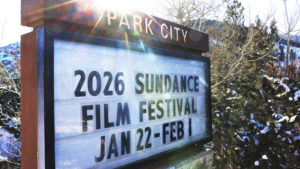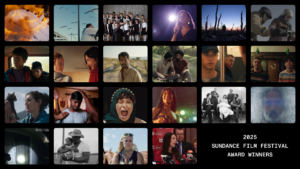A still from Allison Anders and Kurt Voss’s film ‘Strutter.’
Allison Anders and Kurt Voss
As they attempt to raise distribution funds through Kickstarter donations, Sundance alumni Allison Anders and Kurt Voss reflect on the challenges of indie filmmaking by viewing the process through the prism of Zen Buddhism.
Although Allison and I have written and directed some 20 movies between us, our latest collaborative feature, Strutter, is to my mind a “first film.” That is to say, it is a film made with beginners’ enthusiasm and a “beginner’s mind”—the latter a Zen concept for approaching a task without preconception, without prejudice, and without allowing experience to limit one’s thinking.
Zen teacher Shunryu Suzuki explains beginner’s mind thusly: “In the beginner’s mind there are many possibilities, in the expert’s mind there are few.” Obviously one is not going to get very far in the production of a “no-budget” feature if one does not consider different strategies and methodologies for problem solving. In the case of Strutter, embracing this challenge was not only essential, but was eventually revealed to be its own reward.
Allison and I began working together at UCLA in the early 1980s, where we collaborated on our “project 2” student films. In 1984, as rank beginners, we decided to dive in and make a no-budget feature set in the post-punk scene of Los Angeles.
The resultant film, shot on black and white for the paltriest of sums, was titled Border Radio, and against all odds it found a theatrical release (and then video distribution, thanks to Mike Nesmith of The Monkees, who took a shine to the film and released it on his Pacific Arts label). More improbably still, Border Radio was re-released nearly 25 years after its initial debut in a digitally restored deluxe edition issued by the prestigious Criterion Collection.
Whereas most films are, as Allison’s pal Robert Altman suggested, “sandcastles” to be briefly admired before being swept back to sea and the “undifferentiated mass,” occasionally a film manages to outlive the time in which it was made. Allison and I have always been delighted that Border Radio has in its way achieved some degree of longevity—and we have often expressed our bemusement that such a scrappy film, made in a genuine state of “beginner’s mind,” should have been able to achieve this fate.
But then there are things we did instinctually in the production of the first film—such as devoting a whole day to capturing the “perfect shot” at “the perfect time,” which became pretty much impossible to replicate once we began working with larger budgets and more traditional shooting schedules. Every trade-off has its benefits, of course, but on the whole, I began to feel over the ensuing years that something had been lost.
And so when we set out to make a new film to complete our “rock trilogy” (Border Radio was followed in 1999 by Sugar Town), we made the conscious decision to shoot the film just as we had back in 1984, which is to say we would act as our own crew, art department, and costumers. We would be both grips and gaffers. A true “DIY” approach, and the conscious embrace of “beginner’s mind.” In the process we picked up quite a few “Zen tips,” as Allison now explains.
Let Go of Being an Expert
When you let go of being an expert, you open up to intuition. It’s so hard to follow your intuition in traditional models of filmmaking, because so many people are involved and the schedule is so fixed based on budget, availabilities, and even the weather. Yes, Kurt Voss and I are veterans. But with Strutter, we were able to reclaim an intuitive approach to filmmaking without unlearning what our years or experience and expertise taught us.
This approach opened us up to surprises and revelations and incorporating those into a looser script to guide the film. And since we had raised our budget through crowd-funding, we had more time to shoot when we needed to, and were able to edit at a pace that made sense. Likewise, by self-distributing, we can release the film when we are absolutely ready.
Use “Don’t Know” Mind
One of the hardest things to own when you’re a filmmaker is admitting what you don’t know, which is ironic, because you are forever supported when you make a movie by people who do know. But it’s important to realize that saying you don’t know is not the same thing as not having a vision. You can envision how you want a scene to look and yet not know how to light it, or how to build the set, or how to sew the costume. But if you can communicate what you want to those who do know, you will have what you envision.
And by admitting what I don’t know, I am constantly asking to be taught, whether it was my first time using green screen (on The Mentalist) or my first time shooting a car chase (on Southland). You won’t learn new great tricks if you don’t admit you don’t know. With Strutter, there was plenty of “don’t know” mind for Kurt and me: it was our first crowd-funded project, it was the first time since Border Radio working without a producer and without a script supervisor, and now my first time self-distributing. And I’m excited because I’ll be learning something new; I will know how to do this after the experience.
Fall Down Seven Times; Get Up Eight Times
Certainly one needs fortitude to produce any film, regardless of budget. In fact, it has been my experience that there is never quite enough money, regardless of the budget level. But of course the challenges are amplified when one is working with essentially “no” budget. (Strutter was crowd-financed for under $25,000, much less than even Border Radio cost a quarter century ago.)
There will be scenes one cannot afford to mount that will need to be restaged or rethought; there will be locations impossible to secure, or temp score which marries beautifully with the rough cut but which simply proves too expensive to buy for the finished film. Worse yet, your tiny DIY feature will be judged against $200 million films, and in certain respects cannot but help be found wanting in comparison ($100 car pile-up, anyone?).
Each of these obstacles will be experienced as a body blow to the filmmaker, and it is easy to despair. But one must learn to embrace these challenges as part of the process. Despite getting winded or even floored, the filmmaker must dust herself off and get back on her feet to continue fighting the good fight.
Let Go of ‘Shoulds’
There are obviously many things one must forego when making a feature with no budget. One succinct tip is to simply leave behind the word “Should.” We “should” have a caterer; we “should” have some extra hands on deck to help us load all this equipment. I am not suggesting surrender of all standards, or all wishes – for instance, Kurt and I definitely feel Strutter “should” have a physical release in the form of DVD and Blu-ray, and we are hoping to accomplish this via your contributions on Kickstarter. We still have time to make our goal, with your help! But “should” we not be able to afford a physical release, we will find an alternate path, no doubt through the Internet.
That being said, you “should” take a moment to check out our Kickstarter page! Good luck with your own DIY feature. Here’s hoping that ‘beginner’s mind’ gets you through the rapids more than once on your journey to completing your project!




